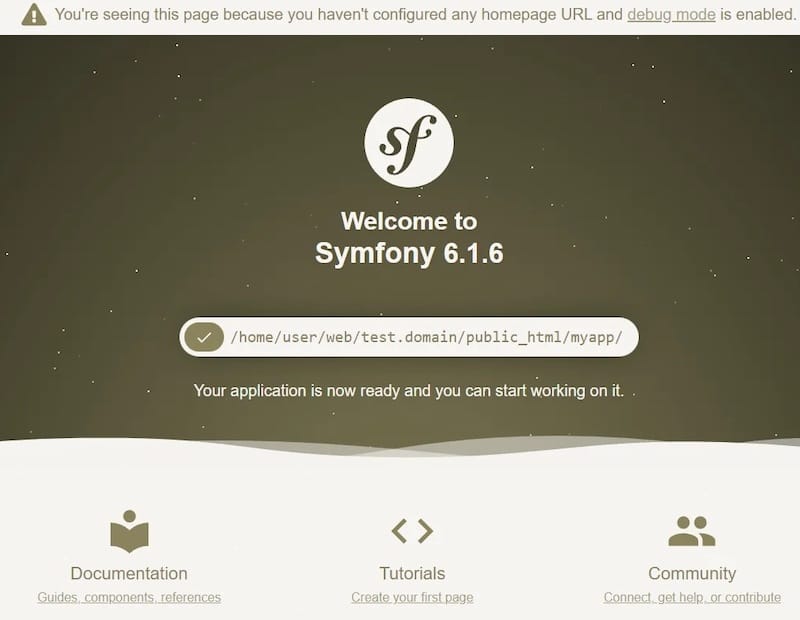How To Install Symfony PHP Framework on Debian 12

In this tutorial, we will show you how to install Symfony PHP Framework on Debian 12. Symfony is a full-stack PHP framework that follows the Model-View-Controller (MVC) architectural pattern, promoting code reusability, maintainability, and scalability. It offers a wide range of features, including routing, database integration, form handling, security, and caching, making it an excellent choice for building complex web applications. By leveraging Symfony’s robust ecosystem and adhering to its best practices, developers can streamline their workflow and deliver high-quality, secure, and maintainable web applications.
This article assumes you have at least basic knowledge of Linux, know how to use the shell, and most importantly, you host your site on your own VPS. The installation is quite simple and assumes you are running in the root account, if not you may need to add ‘sudo‘ to the commands to get root privileges. I will show you the step-by-step installation of the Symfony PHP Framework on a Debian 12 (Bookworm).
Prerequisites
- A server running one of the following operating systems: Debian 12 (Bookworm).
- It’s recommended that you use a fresh OS install to prevent any potential issues.
- SSH access to the server (or just open Terminal if you’re on a desktop).
- Make sure your Debian 12 system is connected to the internet. An active connection is essential for downloading the required packages and updates during the installation.
- A
non-root sudo useror access to theroot user. We recommend acting as anon-root sudo user, however, as you can harm your system if you’re not careful when acting as the root.
Install Symfony PHP Framework on Debian 12 Bookworm
Step 1. Before we install any software, it’s important to make sure your system is up to date by running the following apt commands in the terminal:
sudo apt update sudo apt upgrade
This command updates the package list and upgrades the installed packages to their latest versions.
Step 2. Installing Required Packages.
To successfully install Symfony Framework, you need to install essential packages. Run the following command to install the required packages:
sudo apt install php php-json php-ctype php-curl php-mbstring php-xml php-zip php-tokenizer php-tokenizer libpcre3 git zip unzip
Step 3. Installing Symfony PHP Framework on Debian 12.
To download the Symfony installer script, visit the official Symfony website. You can do this using your preferred web browser. The website is the primary source of Symfony-related resources, and it’s always a good idea to refer to official channels for the most reliable information:
curl -sS https://get.symfony.com/cli/installer | bash
Once Symfony is installed, you will get the following output below:
2023-10-12 10:46:24 (16.6 MB/s) - written to stdout [6300/6300] Symfony CLI installer Environment check [*] cURL is installed [*] Tar is installed [*] Git is installed [*] Your architecture (amd64) is supported
Next, it’s time to pinpoint the exact location of the Symfony system on your system. This can be achieved by executing the following command:
export PATH="$HOME/.symfony5/bin:$PATH" source ~/.bashrc
Step 4. Create Symfony Project.
Now create a new Symfony project by running the following command in your terminal:
symfony new project --full
This command will create a new Symfony project with all the recommended packages and configurations.
Next, navigate to your project and run the web server using the following command:
cd project symfony server:start
Output:
[OK] Web server listening
The Web server is using PHP CLI 8.2
http://127.0.0.1:8000
[Web Server ] Oct 21 11:15:46 |DEBUG | PHP Reloading PHP versions
[Web Server ] Oct 21 11:15:66 |DEBUG | PHP Using PHP version 8.2 (from default version in $PATH)
Step 5. Accessing Symfony Web UI.
Open your web browser and go to http://localhost:8000. If everything is configured correctly, you should see the Symfony welcome page.

Congratulations! You have successfully installed Symfony. Thanks for using this tutorial to install the latest version of Symfony PHP Framework on Debian 12 Bookworm. For additional help or useful information, we recommend you check the official Symfony Framework website.